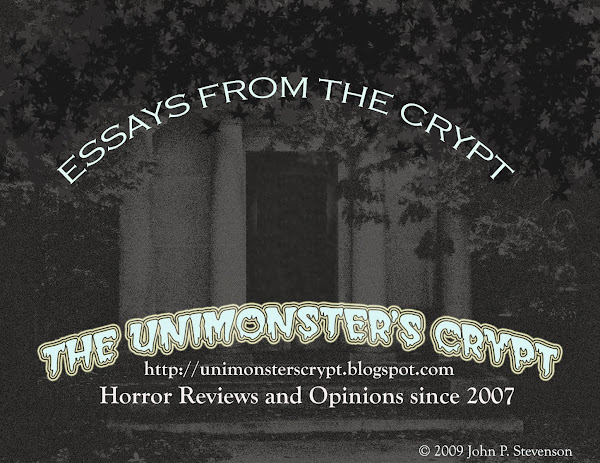Like most things about us, our tastes, whether in movies, music, food, or any facet of popular culture, changes over time. We grow, mature, gain wisdom. What we loved as teens now seem terrible, and vice-versa. Don’t believe me? Dig out those dusty old ABBA albums (if you’re near my age…) and try to sit through one from beginning to end… that’s it, just try. Couldn’t do it, could you? Now, what CD’s are in your car right now? Would you have liked them when you were 15? Not a chance.
Recently, it occurred to me that my tastes in food have altered through the years. Things that I once would’ve given absolutely no thought to trying I now enjoy on a regular basis, while foods that had been my favorites have completely lost their appeal. Similarly, my taste in Horror has altered to a large degree. Though most of the movies that I loved then I still love, that’s far from true in every case.

Now, I don’t mean that I’m somehow “outgrowing” my love of Horror and Science-Fiction films, or that I’ve suddenly developed a fondness for Julia Roberts—Hugh Grant movies. However, it wouldn’t be wrong to say that many of the movies that I loved as a child have since lost whatever appeal they originally had for me, or that I now love movies that, quite frankly, once bored me silly.
When I was ten, in 1974, I was deep into my Monsterkid years. Stacks of Famous Monsters of Filmland magazines filled my room, nestled against equally large stacks of comic books, all watched over by an assortment of Aurora’s Monster models. During this time, I was blessed with an older sister possessed with two enormously beneficial qualities… a car with a spacious trunk, and rather liberal ideas on just what movies our parents would consider acceptable for a ten-year old to see.
NIGHT OF THE LIVING DEAD, THE TEXAS CHAIN SAW MASSACRE, IT’S ALIVE, CHILDREN SHOULDN’T PLAY WITH DEAD THINGS… these are just some of the gorefests I first saw at the local Drive-In, courtesy of my sister. Another movie I owe her for is Herschell G. Lewis’ groundbreaking gore classic, BLOOD FEAST.
BLOOD FEAST, the 1963 film that truly started the splatter genre, impressed me greatly when I first saw it on a long-ago north Florida summer night. Now, though I still recognize it for the pioneer it was, I also recognize that it truly was a stink-fest of a film.
Now I find myself less interested in gore, and more in story. Better able to appreciate the subtleties of a JU-ON or SECRET WINDOW, rather than the sledgehammer of
 FREDDY vs. JASON or HALLOWEEN: RESURRECTION.
FREDDY vs. JASON or HALLOWEEN: RESURRECTION.Believe me, I haven’t totally sworn off spurting blood and torn flesh. Two of the best films of the past five years (SHAUN OF THE DEAD; DOG SOLDIERS…) had more than their share of blood, guts, and gore. They also had exceptionally good stories, great acting, and directors that understood how to make use of all three elements, all things that have become increasingly important to my viewing enjoyment over time. Though film-makers once loaded their films with blood and gore to cover weak scripts and poor production values, modern directors are learning that you can make a good movie that’s also a gory movie.
I also have a much lower tolerance for stupidity than I had at a younger age. Though any good Horror Film requires a certain suspension of disbelief, they should try to make some sense, if only within the confines of the movie itself. One of the better examples of this principle is M. Night Shyamalan’s THE SIXTH SENSE.

This movie established a series of rules for the film’s universe, and played faithfully by them. Thus, when the ending was revealed, the viewer’s first reaction was usually “Damn, I should’ve figured that!” Most movies, however, make no attempt to be so rational, so intelligent. We are simply along for the ride; if the movie makes sense, fine. If not, oh well. Well, I for one have gotten to the point where I need a little rationality in my cinematic fare, a little salve for an old and tired brain that’s seen far too many movies aimed at audiences with an average I.Q. less than their average age.
Thus it is that, more and more, I find myself looking to the classic Universal Horrors, or to the great 1950’s-era Creature Features, for my viewing. There is something refreshing in the simple innocence, the naïveté, of those films. Perhaps it is nostalgia, my pining for my lost youth. Perhaps as I age, my tolerance for blood and guts has diminished. Or perhaps I’ve just grown to expect more from the limited time I can take to watch a movie these days. At best I can squeeze three or four hours of free time out of each day. When I use those for viewing a movie, I don’t usually want to waste the time on CABIN FEVER, or HOUSE OF THE DEAD.
I need entertainment, not shocks… I need Whale and Hitchcock, damnit, not Boll and Roth. I need quality, not quantity. In short, I need my classics.





































